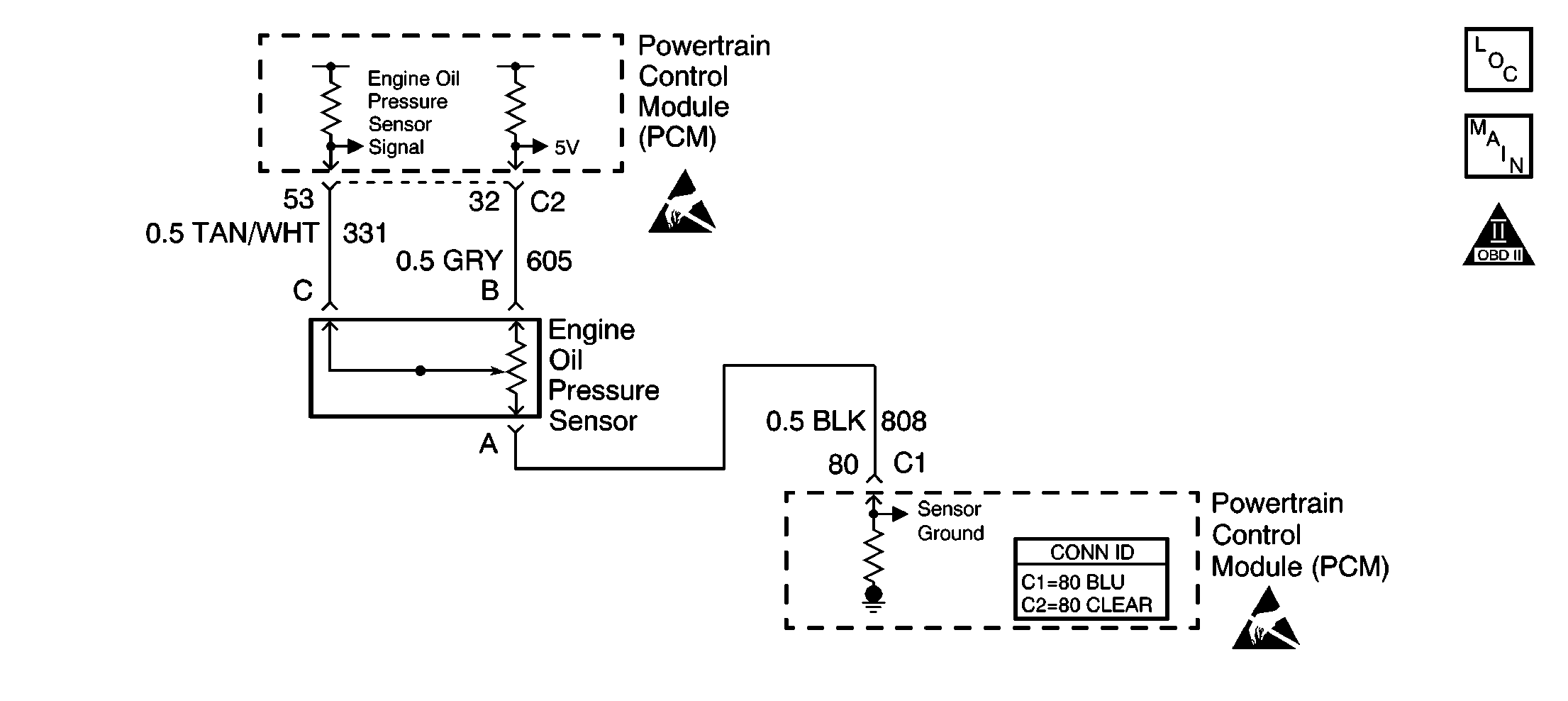
Circuit Description
The engine oil pressure sensor is a solid state transducer. The engine oil pressure sensor sends oil pressure information to the PCM. The PCM transmits the oil pressure information to the instrument panel cluster (IPC) via the serial data CKT 1807.
The engine oil pressure is displayed on the scan tool in volts. A low voltage reading indicates a low oil pressure. As the oil pressure increases, the voltage level also increases. The normal range of the sensor signal voltage is 0.5 volts at 0 kPa (0 psi) to 4.5 volts at 883 kPa (128 psi).
Diagnostic Aids
For diagnosis of the instrument panel, refer to Diagnostic System Check - Instrument Cluster in Instrument Panel, Gauges and Console.
Check for the following conditions:
| • | A faulty connection at the PCM or the engine oil pressure sensor, Inspect harness connectors for the following conditions: |
| - | Backed out terminals |
| - | Improper mating |
| - | Broken locks |
| - | Improperly formed or damaged terminals, use a corresponding mating terminal to test for proper terminal tension. |
| - | Faulty terminal to wire connections |
| • | Inspect the wiring harness for damage. |
| • | The engine oil pressure sensor diagnostic table is intended to isolate electrical faults that affect the engine oil pressure sensor, the PCM, and related circuits. If a problem with engine oil pressure can not be isolated using the diagnostic table, refer to Diagnostic System Check - Instrument Cluster in Instrument Panel, Gauges and Console. |
Test Description
The numbers below refer to the step numbers on the diagnostic table.
-
Tests for the proper operation of the circuit in the low voltage range.
-
Tests for the proper operation of the circuit in the high voltage range. If the fuse in the jumper opens when you perform this test, the signal circuit is shorted to ground.
-
Tests for a short to voltage in the 5 volt reference circuit.
-
Tests for a high resistance or an open in the ground circuit.
-
This vehicle is equipped with a PCM which utilizes an electrically erasable programmable read-only memory (EEPROM). If the PCM is replaced, the new PCM must be programmed.
Step | Action | Value(s) | Yes | No |
|---|---|---|---|---|
1 | Did you perform the Powertrain On Board Diagnostic (OBD) System Check? | -- | Go to Step 2 | |
2 |
Is the oil pressure within the specified range? | 4.5-5.0 V | Go to Diagnostic Aids | Go to Step 3 |
Does the scan tool indicate that the oil pressure sensor data parameter is less than the specified value? | 4.5 V | Go to Step 4 | Go to Step 10 | |
Is the oil pressure more than the specified value? | 5.0 V | Go to Step 5 | Go to Step 8 | |
Is the voltage less than the specified value? | 4.9 V | Go to Step 6 | Go to Step 7 | |
Caution: Unless directed otherwise, the ignition and start switch must be in the OFF or LOCK position, and all electrical loads must be OFF before servicing any electrical component. Disconnect the negative battery cable to prevent an electrical spark should a tool or equipment come in contact with an exposed electrical terminal. Failure to follow these precautions may result in personal injury and/or damage to the vehicle or its components. Is the resistance less than the specified value? | 5 ohms | Go to Step 12 | Go to Step 11 | |
7 | Test the 5 volt reference circuit of the sensor for a short to voltage. Refer to Circuit Testing and Wiring Repairs in Wiring Systems . Did you find and correct the condition? | -- | Go to Step 16 | Go to Step 13 |
8 | Test the 5 volt reference circuit of the sensor for a short to ground, a high resistance, or an open. Refer to Circuit Testing and Wiring Repairs in Wiring Systems . Did you find and correct the condition? | -- | Go to Step 16 | Go to Step 9 |
9 | Test the signal circuit of the sensor for a short to ground, a high resistance, or an open. Refer to Circuit Testing and Wiring Repairs in Wiring Systems . Did you find and correct the condition? | -- | Go to Step 16 | Go to Step 13 |
10 | Test the signal circuit of the sensor for a short to voltage. Refer to Circuit Testing and Wiring Repairs in Wiring Systems . Did you find and correct the condition? | -- | Go to Step 16 | Go to Step 13 |
11 |
Did you find and correct the condition? | -- | Go to Step 16 | Go to Step 13 |
12 | Inspect for faulty connections at the harness connector of the sensor. Refer to Testing for Intermittent Conditions and Poor Connections and Connector Repairs in Wiring Systems . Did you find and correct the condition? | -- | Go to Step 16 | Go to Step 14 |
13 | Inspect for faulty connections at the harness connector of the PCM. Refer to Testing for Intermittent Conditions and Poor Connections and Connector Repairs in Wiring Systems. Did you find and correct the condition? | -- | Go to Step 16 | Go to Step 15 |
14 | Replace the oil pressure sensor. Did you complete the repair? | -- | Go to Step 16 | -- |
|
Important: The replacement PCM must be programmed. Replace the PCM. Refer to Powertrain Control Module Replacement/Programming . Did you complete the repair? | -- | Go to Step 16 | -- | |
16 |
Does the DTC reset? | -- | Go to Step 2 | System OK |
